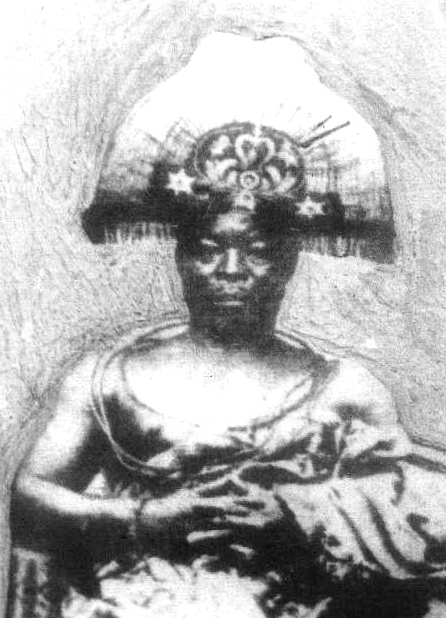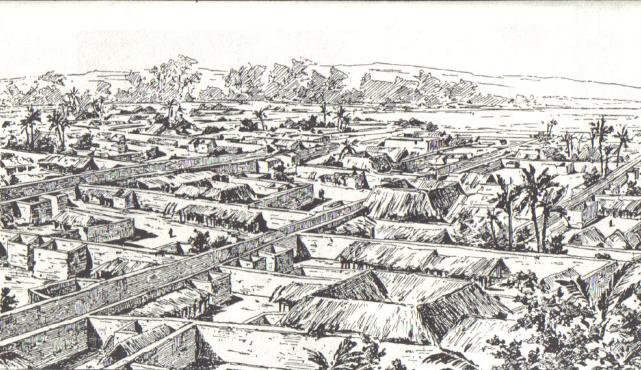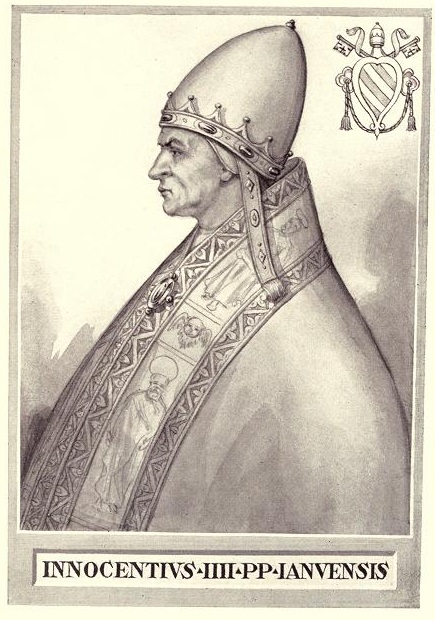|
Uwakhuahen
Uwakhuahen was the second Oba of the Kingdom of Benin, reigning from 1235 AD to 1243 AD. He was the son of Eweka I, the initiator of the Oba dynasty and the inaugural ruler to bear the title Oba. Upon the demise of his father, he ascended to the throne, although he did not designate an heir apparent. Biography Uwakhuahen, along with Idu and Ehenmihen, were the progeny of Eweka I. As per oral tradition, following the death of Eweka I, the Uzama The Uzama Nihiron also known as King Makers in the Benin Kingdom, are among the highest ranking chiefs in Benin History. Just like the Oyomesi of the old Oyo empire, the Uzama are saddled with the responsibility of crowning a new king in the Benin ... resolved that one of his sons should be inaugurated as the new Oba. They favoured Uwakhuahen over his elder brother Idu, who was the rightful heir according to the principle of primogeniture. The Uzama conspired and requested Idu to provide a cow with a bird's nest built upon its head for t ... [...More Info...] [...Related Items...] OR: [Wikipedia] [Google] [Baidu] |
Eweka I
Eweka I (reigned 1200 AD – 1235 AD) was the first Oba of Benin and presided over the kingdom's shift from the Ogiso monarchy to the establishment of the Obaship. His 35-year reign had a notable impact on the political, cultural, and traditional aspects of the kingdom. Before Eweka I's rule, the Benin Kingdom faced uncertainty due to the banishment of Owodo, the last Ogiso, for misrule. Oduduwa, who was the father of Oromiyan had been exiled to Uhe (Ife), which eventually set the stage for Eweka I's ascension to power. The turning point occurred when Oduduwa sent his son, Oromiyan, to Benin as an emissary. Oromiyan's arrival was met with resistance, leading to his settlement in Usama, on the outskirts of Benin City. To gauge the loyalty of the Benin people, Oromiyan challenged them to care for a common louse for three years, symbolising their commitment to their potential king. Oromiyan resided in a palace constructed for him within the city of Benin. During his time there, ... [...More Info...] [...Related Items...] OR: [Wikipedia] [Google] [Baidu] |
Kingdom Of Ugu
The Kingdom of Ugu is a kingdom that exists in Nigeria, in what is now Edo State. The Edo State is also called Benin, though it is not to be confused with the country. The Kingdom of Ugu originated out of Igodomigodo in Nigeria. Origin "Sometime in the thirteenth century A.D., a period that was probably one of dynastic crisis and transition, The Ogiso dynasty collapsed due partly to internal feuds and the tyranny of Ogiso Owodo. Alongside Igodomigodo polity (later known as Benin) were Udo to the west and Iguobode in Iyekorhionmwon area to the east, and possibly other Edo-speaking polities. What immediately followed the collapse of Ogiso rulership was decentralized political authority. Many autonomous principalities emerged with leaders struggling to establish their own dynastic hegemony over surrounding areas. How long this situation lasted is not clear but oral historical sources and archaeological data soundly indicate that centralized political authority and a new kingship dynas ... [...More Info...] [...Related Items...] OR: [Wikipedia] [Google] [Baidu] |
Oba Of Benin
The Oba of Benin is the traditional ruler and the custodian of the culture of the Edo people and all Edoid people. The then Kingdom of Benin (not to be confused with the modern-day and unrelated Republic of Benin, which was then known as Dahomey) has continued to be mostly populated by the Edo (also known as Benin ethnic group). The dynasty is sometimes called the "Eweka dynasty", after its first ruler, Eweka I, and was preceded by the Ogiso monarchy. In 1897, a British military force of approximately 1,200 men under the command of Sir Harry Rawson mounted the Benin punitive Expedition. The force was dispatched in retaliation to the ambush of a British party, at Ugbine village near Gwato on 4 January 1897 by a group of Benin soldiers who were acting without orders from the Oba; the ambush had led to the deaths of all but two of the British party. The British force captured the capital of the Kingdom of Benin, sacking and burning the city while forcing the Oba of Benin, Ov ... [...More Info...] [...Related Items...] OR: [Wikipedia] [Google] [Baidu] |
Benin City
Benin City serves as the Capital city, capital and largest Metropolitan area, metropolitan centre of Edo State, situated in Nigeria, southern Nigeria. It ranks as the List of Nigerian cities by population, fourth-most populous city in Nigeria, according to the Census in Nigeria, 2006 national census, preceded by Lagos, Kano (city), Kano, and Ibadan. Geography Benin City is located in close proximity to the Benin River, situated approximately to the north, whilst its eastern perimeter lies from Lagos via the arterial road network. The city's municipal boundaries converge with those of several prominent neighbouring towns in Nigeria, southern Nigeria, notably Agbor, Oghara, and Ekpoma. Agriculture Benin City boasts an exceptionally fertile agricultural landscape and serves as the epicentre of Nigeria's thriving Natural rubber, rubber industry. Additionally, the production of palm oil constitutes a substantial sector, further underscoring the city's prominence in Nigeria ... [...More Info...] [...Related Items...] OR: [Wikipedia] [Google] [Baidu] |
Kingdom Of Benin
The Kingdom of Benin, also known as Great Benin, is a traditional kingdom in southern Nigeria. It has no historical relation to the modern republic of Benin, which was known as Dahomey from the 17th century until 1975. The Kingdom of Benin's capital was Edo, now known as Benin City in Edo State, Nigeria. The Benin Kingdom was one of the oldest and most developed State (polity), states in the coastal hinterland of West Africa. It grew out of the previous Edo people, Edo Kingdom of Igodomigodo around the 11th century AD; it was annexed by the British Empire in 1897, but endured as a non-sovereign monarchy. In the 15th and 16th centuries, the kingdom reached the height of its prosperity, expanding its territory, trading with European powers, and creating a remarkable artistic legacy in cast bronze, iron, brass, carved ivory, and other materials. History Early By the 1st century BC, the Benin territory was partially agricultural; and it became primarily agricultural by around A. ... [...More Info...] [...Related Items...] OR: [Wikipedia] [Google] [Baidu] |
Uzama
The Uzama Nihiron also known as King Makers in the Benin Kingdom, are among the highest ranking chiefs in Benin History. Just like the Oyomesi of the old Oyo empire, the Uzama are saddled with the responsibility of crowning a new king in the Benin Kingdom (modern day Benin City). From ancient Benin History, the Uzama reign started during the Ogiso era and they consist of four chiefs which is headed by Chief Oliha. Other chiefs holding the Uzama title include Edohen, Ezomo, Ero, Eholo Nire and Oloton. While the Chiefs were responsible for crowning the King or the Oba of Benin, they do not have the power to choose the king. See also * Kingdom of Benin * Oba of Benin * List of the Ogiso ''Ogiso'' is the name used by the people of Igodomigodo or (Ugodomigodo) to refer to the institution and first dynasty of rulers beginning approximately around 900 - 950AD or the mid tenth century. The name variously translates to mean 'King fro ... References Kingdom of Benin {{Nig ... [...More Info...] [...Related Items...] OR: [Wikipedia] [Google] [Baidu] |
1243 Deaths
Year 1243 ( MCCXLIII) was a common year starting on Thursday of the Julian calendar. Events By place Europe * March – King Ferdinand III (the Saint) turns the independent Taifa of Murcia into a protectorate, and initiates the process of the colonization and Christianization of the region. He receives the submission of the Moors, under the terms of a peace agreement (the famous Treaty of Alcaraz). * April 27 – Treaty of Bordeaux: King Louis IX (the Saint) and King Henry III agree to a truce that ends the Saintonge War. The truce does not stop the on-going clashes (and further tensions) between France and England. * Siege of Viterbo: Emperor Frederick II besieges Viterbo on request of the rebel citizens. The defenders are able to set fire to the siege towers and after signing a peace treaty, Frederick is persuaded to withdraw his army. * Siege of Montségur: French forces (some 10,000 men) begin the siege of Château de Montségur to raze the stronghol ... [...More Info...] [...Related Items...] OR: [Wikipedia] [Google] [Baidu] |
13th-century Monarchs In Africa
The 13th century was the century which lasted from January 1, 1201 (represented by the Roman numerals MCCI) through December 31, 1300 (MCCC) in accordance with the Julian calendar. The Mongol Empire was founded by Genghis Khan, which stretched from Eastern Asia to Eastern Europe. The conquests of Hulagu Khan and other Mongol invasions changed the course of the Muslim world, most notably the Siege of Baghdad (1258) and the destruction of the House of Wisdom. Other Muslim powers such as the Mali Empire and Delhi Sultanate conquered large parts of West Africa and the Indian subcontinent, while Buddhism witnessed a decline through the conquest led by Bakhtiyar Khilji. The earliest Islamic states in Southeast Asia formed during this century, most notably Samudera Pasai. The Kingdoms of Sukhothai and Hanthawaddy would emerge and go on to dominate their surrounding territories. Europe entered the apex of the High Middle Ages, characterized by rapid legal, cultural, and religious evo ... [...More Info...] [...Related Items...] OR: [Wikipedia] [Google] [Baidu] |
Nigerian Military Personnel
Nigerians or the Nigerian people are citizens of Nigeria or people with ancestry from Nigeria. The name Nigeria was derived from the Niger River running through the country. This name was allegedly coined in the late 19th century by British journalist Flora Shaw, who later married Baron Frederick Lugard, a British colonial administrator. Nigeria is composed of various ethnic groups and cultures and the term Nigerian refers to a citizenship-based civic nationality. Nigerians are derived from over 250 ethno-linguistic groups.Toyin Falola. ''Culture and Customs of Nigeria''. Westport, Connecticut, USA: Greenwood Press, 2001. p. 4. Though there are multiple ethnic groups in Nigeria, economic factors result in significant mobility of Nigerians of multiple ethnic and religious backgrounds to reside in territories in Nigeria that are outside their ethnic or religious background, resulting in the mixing of the various ethnic and religious groups, especially in Nigeria's cities.Toyin Fal ... [...More Info...] [...Related Items...] OR: [Wikipedia] [Google] [Baidu] |



